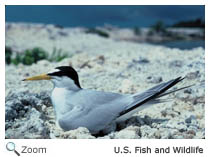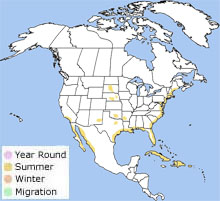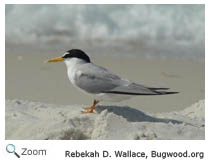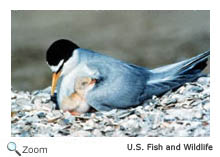Description
 The least tern is a small, slender tern 8-9
inches in length with a wingspan of
19-20
inches. It has a white throat, breast and belly and a soft gray back and wings. It has short legs; long, pointed wings, and a forked tail. In the winter, its head is a mottled gray, and it has a black eye stripe and a long pointed black bill. In the breeding season, it has a black head, a black stripe that runs from its bill to its eyes, and a yellow bill with a black tip. Males and females look alike. The least tern is a small, slender tern 8-9
inches in length with a wingspan of
19-20
inches. It has a white throat, breast and belly and a soft gray back and wings. It has short legs; long, pointed wings, and a forked tail. In the winter, its head is a mottled gray, and it has a black eye stripe and a long pointed black bill. In the breeding season, it has a black head, a black stripe that runs from its bill to its eyes, and a yellow bill with a black tip. Males and females look alike.
Range
 The least tern breeds along the Atlantic Coast from Maine south to Florida and along the Gulf Coast south to Mexico. It also breeds along the Pacific Coast from California south to Mexico. It also breeds in isolated areas inland along the
Missouri, Ohio, and Mississippi Rivers inland to Montana, Kentucky, and Missouri. It is also found in scattered areas in New Mexico, Texas, Colorado, and Nebraska.
It winters along the Atlantic, Pacific, and Gulf Coasts south to Mexico. The least tern is also found in
Central America and the Caribbean.
The least tern is on the U.S. Endangered Species List and is an endangered species in New Hampshire. There are records of the least tern breeding in New Hampshire in Seabrook between 1953 and 1960, but the least tern has been considered a non-breeding species in New Hampshire since 1980. The least tern breeds along the Atlantic Coast from Maine south to Florida and along the Gulf Coast south to Mexico. It also breeds along the Pacific Coast from California south to Mexico. It also breeds in isolated areas inland along the
Missouri, Ohio, and Mississippi Rivers inland to Montana, Kentucky, and Missouri. It is also found in scattered areas in New Mexico, Texas, Colorado, and Nebraska.
It winters along the Atlantic, Pacific, and Gulf Coasts south to Mexico. The least tern is also found in
Central America and the Caribbean.
The least tern is on the U.S. Endangered Species List and is an endangered species in New Hampshire. There are records of the least tern breeding in New Hampshire in Seabrook between 1953 and 1960, but the least tern has been considered a non-breeding species in New Hampshire since 1980. Habitat  The least tern is found on
sandy and pebbly beaches and on sandbars in large rivers. The least tern is found on
sandy and pebbly beaches and on sandbars in large rivers.
| | | |
DietThe least tern dives into the water from the air and catches small fish and invertebrates.
Life Cycle
 The least tern nests in colonies on sandy or pebbly beaches or sandbars. It often nests with piping plovers. The female lays 2-3 eggs in a scrape on the ground. Sometimes, the nest is lined with broken shells.
Occasionally, the least tern nests on the gravel roofs of buildings! The eggs are incubated for 21-23 days by both parents.
The parents aggressively protect their nesting site and dive and scream at intruders. The chicks leave the nest a few days after hatching. They fledge when they are 19-20 days old, but their parents continue to feed and care for them until they migrate in the fall. The least tern nests in colonies on sandy or pebbly beaches or sandbars. It often nests with piping plovers. The female lays 2-3 eggs in a scrape on the ground. Sometimes, the nest is lined with broken shells.
Occasionally, the least tern nests on the gravel roofs of buildings! The eggs are incubated for 21-23 days by both parents.
The parents aggressively protect their nesting site and dive and scream at intruders. The chicks leave the nest a few days after hatching. They fledge when they are 19-20 days old, but their parents continue to feed and care for them until they migrate in the fall.
Behavior  The least tern was close to extinction in the late 1900s. It was hunted for its feathers, which were used to decorate ladies hats. Today, the least tern is endangered because of where it builds its nest, from loss of nesting habitat, and from predation. The least tern was close to extinction in the late 1900s. It was hunted for its feathers, which were used to decorate ladies hats. Today, the least tern is endangered because of where it builds its nest, from loss of nesting habitat, and from predation.
 The least tern nests on beaches. Much of its nesting territory has been taken over by human development. The nesting habitat that is left is often used by people for recreation and least tern eggs are sometimes destroyed when people step on them. The least tern is easily frightened and sometimes abandons its nest if it has been disturbed. It also builds its nests on low-lying sandbars. Nests are sometimes swept away by high tides. Least tern eggs and chicks are also eaten by rats, skunks, raccoons, and even cats and dogs. The least tern nests on beaches. Much of its nesting territory has been taken over by human development. The nesting habitat that is left is often used by people for recreation and least tern eggs are sometimes destroyed when people step on them. The least tern is easily frightened and sometimes abandons its nest if it has been disturbed. It also builds its nests on low-lying sandbars. Nests are sometimes swept away by high tides. Least tern eggs and chicks are also eaten by rats, skunks, raccoons, and even cats and dogs.
|



 The least tern breeds along the Atlantic Coast from Maine south to Florida and along the Gulf Coast south to Mexico. It also breeds along the Pacific Coast from California south to Mexico. It also breeds in isolated areas inland along the
Missouri, Ohio, and Mississippi Rivers inland to Montana, Kentucky, and Missouri. It is also found in scattered areas in New Mexico, Texas, Colorado, and Nebraska.
It winters along the Atlantic, Pacific, and Gulf Coasts south to Mexico. The least tern is also found in
Central America and the Caribbean.
The least tern is on the U.S. Endangered Species List and is an endangered species in New Hampshire. There are records of the least tern breeding in New Hampshire in Seabrook between 1953 and 1960, but the least tern has been considered a non-breeding species in New Hampshire since 1980.
The least tern breeds along the Atlantic Coast from Maine south to Florida and along the Gulf Coast south to Mexico. It also breeds along the Pacific Coast from California south to Mexico. It also breeds in isolated areas inland along the
Missouri, Ohio, and Mississippi Rivers inland to Montana, Kentucky, and Missouri. It is also found in scattered areas in New Mexico, Texas, Colorado, and Nebraska.
It winters along the Atlantic, Pacific, and Gulf Coasts south to Mexico. The least tern is also found in
Central America and the Caribbean.
The least tern is on the U.S. Endangered Species List and is an endangered species in New Hampshire. There are records of the least tern breeding in New Hampshire in Seabrook between 1953 and 1960, but the least tern has been considered a non-breeding species in New Hampshire since 1980.


